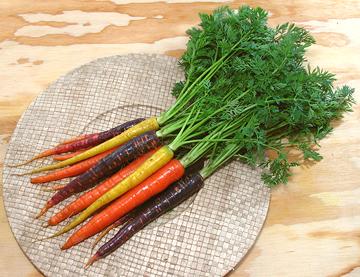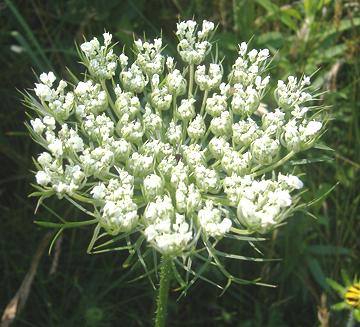 [Daucus carota subsp. sativus]
[Daucus carota subsp. sativus]
Descended from wild carrots (see below) domestic carrots were originally grown for leaves and seeds used as flavorings. As varieties with larger non-woody tap roots were developed the carrot became a common root vegetable. The orange root carrot so familiar today first appeared in the Netherlands during the 17th century.
The Afghan ancestors of our common carrots are commonly purple or yellow and often have branched roots. In Imperial Rome carrots were generally white or purple. Our market varieties are naturally white or orange, but yellow, red, maroon, purple and nearly black varieties have been developed, and one that's purple on the outside and orange on the inside. Some have been developed with particular medicinal properties.
More on Parsleys
Various shapes, sizes and colors are grow. In Georgia, a wide blocky variety is hollowed out and stuffed.
Carrots are best stored without washing, loosely wrapped in plastic and refrigerated. They'll last a couple of months. Instead I scrub mine before bagging and they still last more than a month.
 [Queen Anne's Lace, Bishops Lace, Bird's Nest, Daucus carota,
Daucus pusillus (American)]
[Queen Anne's Lace, Bishops Lace, Bird's Nest, Daucus carota,
Daucus pusillus (American)]
Probably originating in Afghanistan. D. carota varieties are now native to southwest Asia, Europe and northeast North America. D. pusillus is native to the southeast, mountain west and west coast of the US and into British Columbia.
Like the domestic carrot the wild carrot produces edible tap roots, but
they are small and edible only when quite young, turning woody as they
mature. A teaspoon of the seeds has been known since ancient times to
be a natural form of birth control, disrupting the egg implantation
process. Great care must be taken gathering this herb in the wild because
it is very similar to toxic Water Hemlock (genus Cicuta). Note that
flower stems of wild carrot are distinctly hairy and those of most toxic
imitators are not.
Photo by Rangeley distributed under
GNU Free Documentation License v1.2.